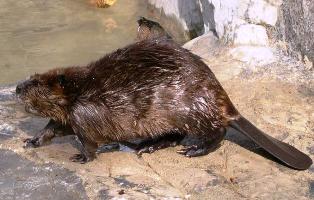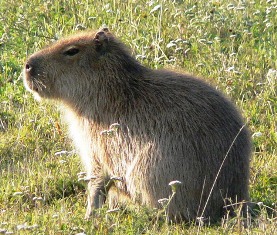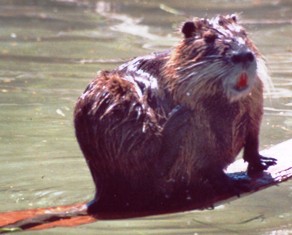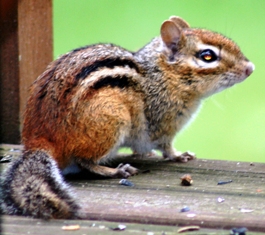Discover Florida Nature
It's time to explore the natural Florida


|
|
|
|
|
With over 2000 living species placed in about 30 families, rodents are
by far the largest order of mammals. Rodents range in size from the
pygmy mice to capybaras, the largest of which weigh over 150 pounds.
Some Florida rodents spend their entire lives above the ground in the
canopy of trees; others seldom emerge from beneath the ground. Some
species are highly aquatic, while others are equally specialized for
life in deserts.  American
Beaver-
The American beaver is typically dark, reddish brown but varies from a
yellowish brown to almost black. They have a very distinctive flattened,
scaly tail, which is a fat storage area. The beaver's hind feet are
webbed and clawed, and their front feet are smaller and not webbed.
American beavers aquatic habits are accommodated by valves that can
close off the ears and nose when underwater, and a clear membrane that
closes over the eyes. Their lips seal behind their incisors, which
allows them to gnaw wood underwater. The American beaver's total length
is 40 to 52 inches, with a tail length of 10.4 to 13 inches, and they
weigh 22 to 75 pounds. Beavers are dependent on slow-flowing brooks,
streams, and rivers for dam construction, but they do also live in small
lakes and rivers in Northern Florida. American beavers prefer bark of
deciduous trees such as aspen, willow, birch and even maple as well as
various woody shrubs. . They also eat roots of tuberous aquatic plants,
especially pond lilies which they utilize more during summer months.
They do not eat fish or other aquatic animals, which is contrary to what
many people think. American
Beaver-
The American beaver is typically dark, reddish brown but varies from a
yellowish brown to almost black. They have a very distinctive flattened,
scaly tail, which is a fat storage area. The beaver's hind feet are
webbed and clawed, and their front feet are smaller and not webbed.
American beavers aquatic habits are accommodated by valves that can
close off the ears and nose when underwater, and a clear membrane that
closes over the eyes. Their lips seal behind their incisors, which
allows them to gnaw wood underwater. The American beaver's total length
is 40 to 52 inches, with a tail length of 10.4 to 13 inches, and they
weigh 22 to 75 pounds. Beavers are dependent on slow-flowing brooks,
streams, and rivers for dam construction, but they do also live in small
lakes and rivers in Northern Florida. American beavers prefer bark of
deciduous trees such as aspen, willow, birch and even maple as well as
various woody shrubs. . They also eat roots of tuberous aquatic plants,
especially pond lilies which they utilize more during summer months.
They do not eat fish or other aquatic animals, which is contrary to what
many people think. Capybara-
Strange sheep-sized rodents with webbed feet are showing up in Florida’s
rivers and canals! These weird looking animals are capybara – a 100-lb
guinea-pig-like creature. Capybaras have heavy, barrel-shaped bodies
with short heads. Their fur is reddish brown on the upper parts and
yellowish brown underneath. Adult capybaras may be as long as four feet
and are 1.6 feet tall. Capybara spend most of their time grazing in
dense grass and swampy vegetation around rivers, lakes and marshes. They
can run fast, and if they feel threatened will dive into the water and
swim with only their nostrils, eyes and ears above the surface. Today,
capybara are native to Central and South America, found from Panama
south to Argentina. But they used to live as far north as Florida.
Eleven thousand years ago, in the Pleistocene, two species of capybara
roamed the grasslands and waterways of peninsula Florida. The capybara
that are being seen today are most likely the descendents of escaped
captives, but people still find fossilized capybara teeth and bones from
Florida’s original capybara in the Santa Fe,
Suwannee,
St Marks and St Mary’s Rivers in North Florida. You may also find
capybara fossils in springs and spring runs like the Ichneetucknee
River. Capybara-
Strange sheep-sized rodents with webbed feet are showing up in Florida’s
rivers and canals! These weird looking animals are capybara – a 100-lb
guinea-pig-like creature. Capybaras have heavy, barrel-shaped bodies
with short heads. Their fur is reddish brown on the upper parts and
yellowish brown underneath. Adult capybaras may be as long as four feet
and are 1.6 feet tall. Capybara spend most of their time grazing in
dense grass and swampy vegetation around rivers, lakes and marshes. They
can run fast, and if they feel threatened will dive into the water and
swim with only their nostrils, eyes and ears above the surface. Today,
capybara are native to Central and South America, found from Panama
south to Argentina. But they used to live as far north as Florida.
Eleven thousand years ago, in the Pleistocene, two species of capybara
roamed the grasslands and waterways of peninsula Florida. The capybara
that are being seen today are most likely the descendents of escaped
captives, but people still find fossilized capybara teeth and bones from
Florida’s original capybara in the Santa Fe,
Suwannee,
St Marks and St Mary’s Rivers in North Florida. You may also find
capybara fossils in springs and spring runs like the Ichneetucknee
River. Coypu-
Coypu, or Nutria as they are sometimes called, are covered with a soft,
dense, slate-colored coat with long bristles. The tail is covered with
scales and is round. The coypu's eyes and ears are small, and the snout
has long whiskers. The hind feet of the coypu are partly webbed and
hairless. The incisors are large, conspicuous, and yellow. The coypu
grows over two feet long, with another eighteen inches for the tail. It
can weigh twenty pounds. The coypu swims skillfully and is mainly active
at dusk, although also during the day. It spends the night in its deep
burrow, which is dug on dry land, and it lives in quite large groups.
Coypu eat aquatic plants, earthworms, and bivalve mollusks. Coypu's
spend a great deal of time grooming their coat, first dampening it with
a liquid secreted by glands situated near its mouth, and then cleaning
and combing industriously with its claws. Predators of the coypu include
wild cats, red wolves, large
snakes, and people (who raise and kill coypu for its soft undercoat and
its meat). When in danger, the coypu often goes into the water; it is a
strong swimmer but is clumsy on land. Females give birth to a litter of
4-6 young in a litter. Newborns have hair and teeth at birth; their eyes
are open as newborns. Nutrias are mature at about 6 months of age. Adult
females have 2 to 3 litters each year. Coypu-
Coypu, or Nutria as they are sometimes called, are covered with a soft,
dense, slate-colored coat with long bristles. The tail is covered with
scales and is round. The coypu's eyes and ears are small, and the snout
has long whiskers. The hind feet of the coypu are partly webbed and
hairless. The incisors are large, conspicuous, and yellow. The coypu
grows over two feet long, with another eighteen inches for the tail. It
can weigh twenty pounds. The coypu swims skillfully and is mainly active
at dusk, although also during the day. It spends the night in its deep
burrow, which is dug on dry land, and it lives in quite large groups.
Coypu eat aquatic plants, earthworms, and bivalve mollusks. Coypu's
spend a great deal of time grooming their coat, first dampening it with
a liquid secreted by glands situated near its mouth, and then cleaning
and combing industriously with its claws. Predators of the coypu include
wild cats, red wolves, large
snakes, and people (who raise and kill coypu for its soft undercoat and
its meat). When in danger, the coypu often goes into the water; it is a
strong swimmer but is clumsy on land. Females give birth to a litter of
4-6 young in a litter. Newborns have hair and teeth at birth; their eyes
are open as newborns. Nutrias are mature at about 6 months of age. Adult
females have 2 to 3 litters each year.  Eastern
Chipmunk-
The eastern chipmunk has reddish-brown fur on its back and sides and
white fur on its stomach. It has two white stripes bordered by black on
its sides and one black stripe on the center of its back. The eastern
chipmunk has light stripes above and below its eyes and it has pouched
cheeks that it uses to store and carry food. The eastern chipmunk, a
species special concern
in Florida, lives in open deciduous forests and at the edges of
woodlands. It can also be found in bushy areas and in rocky areas like
walls near houses and other buildings. The eastern chipmunk spends a
large part of its waking hours gathering and storing food for the
winter. Eastern chipmunks are also very vocal and can be heard
chattering as they gather food. In fact, they get their name chipmunk
from the "chip-chip" sound that they make! Most of the eastern
chipmunk's diet is made up of nuts, acorns, seeds, mushrooms, fruits,
berries and corn. It also eats insects, bird eggs, snails and small
mammals like young mice. Eastern
Chipmunk-
The eastern chipmunk has reddish-brown fur on its back and sides and
white fur on its stomach. It has two white stripes bordered by black on
its sides and one black stripe on the center of its back. The eastern
chipmunk has light stripes above and below its eyes and it has pouched
cheeks that it uses to store and carry food. The eastern chipmunk, a
species special concern
in Florida, lives in open deciduous forests and at the edges of
woodlands. It can also be found in bushy areas and in rocky areas like
walls near houses and other buildings. The eastern chipmunk spends a
large part of its waking hours gathering and storing food for the
winter. Eastern chipmunks are also very vocal and can be heard
chattering as they gather food. In fact, they get their name chipmunk
from the "chip-chip" sound that they make! Most of the eastern
chipmunk's diet is made up of nuts, acorns, seeds, mushrooms, fruits,
berries and corn. It also eats insects, bird eggs, snails and small
mammals like young mice. |
|
|
Advertise | Privacy Statement | Dog Encyclopedia | Video |Contact | Alaska Nature |
|